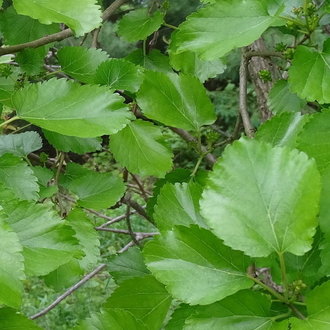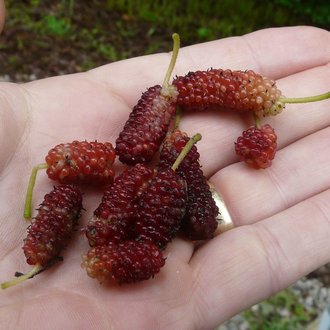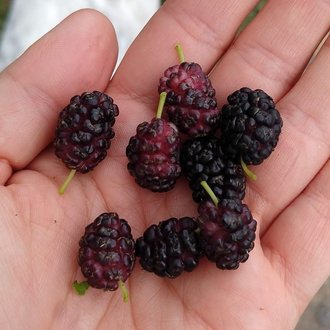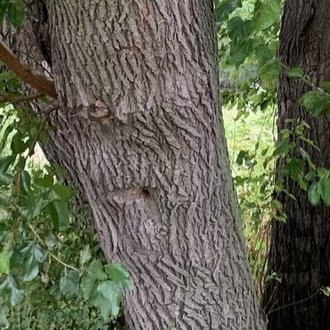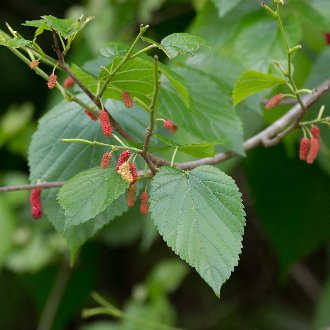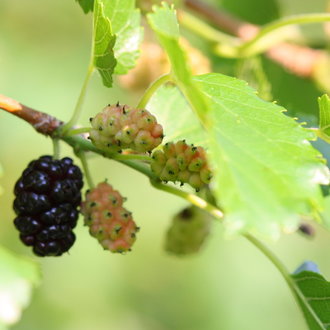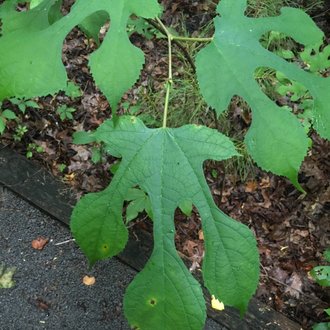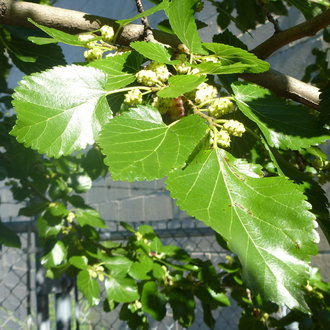Red Mulberry vs White Mulberry
These species are usually easy to tell apart if looking at a pure species, but they readily hybridize and form intergrades, and it may not be possible to identify all individuals. The native red mulberry mostly occurs in mature bottomland forests whereas the invasive white mulberry ranges farther north and west, and is more likely as a pioneer species in disturbed habitats.
Red Mulberry (Morus rubra) | White Mulberry (Morus alba) |
A native tree of moist, mature forests in eastern North America, threatened by hybridization with the introduced white mulberry. | A tree native to northern China; introduced in North America, where it is widely considered invasive and hybridizes with the native red mulberry. |
Leaves much longer (4-7in / 10-18cm), always long-acuminate (tapering to a conspicuous, long point at their tip). Side-lobes, when present, are also acuminate. Photo © Claire Secrist, Public Domain. | Leaves much shorter (3-4 in / 8-10cm), only sometimes taper to a long point at their tip; some leaves may look blunt-tipped. Photo © Reuven Martin, Public Domain. |
Leaves pubescent underneath, with pubescence covering all veins, even smaller side veins. Photo © Nate Martineau, CC BY 4.0. | Leaves minimally pubescent underneath; there are sometimes sparse hairs on major veins, especially where they branch, but overall much less pubescence. Photo © botanygirl, CC BY 4.0. |
Fruit is longer, usually 2-3 cm long. Photo © kent, Public Domain. | Fruit is shorter, usually at most 2 cm long. Photo © Hamilton Turner, Public Domain. |
Bark averages greyer. Bark texture is scaly, with straight ridges. Trunk is usually straighter, at least towards the bottom, and tree is more likely to have a single-trunk habit. Photo © askalotl, Public Domain. | Bark has a slightly warmer color, tan or brownish. Texture looks almost braided, with ridges that twist back and forth. Trunks are usually crooked or leaning and trees are more likely to have multiple trunks. Photo © CK Kelly, CC BY 4.0. |
Fruit often borne singly in leaf axils, more spread out throughout tree. When clusters exist they are smaller. Photo © Lillie, CC BY 4.0. | Fruit often borne in clusters, with more berries per cluster. Photo © Scott Loarie, Public Domain. |
Foliage is usually less shiny. Photo © Abbie King, CC BY 4.0. | Foliage is often very shiny. Photo © Ira Gershenhorn, Public Domain. |
Additional Notes
Some sources cite differences in fruit color between these species. Although there may be average differences in fruit color, the color of ripe fruit of both species varies considerably from tree to tree; white mulberry has a particularly large range of fruit color, ranging from the occasional tree with fruit that is white when ripe, to deep purplish-black (which is more common), and everything in-between. The widely-used common names "white" and "red" can unfortunately be misleading, as can the common name of another introduced species, black mulberry (Morus nigra).The morphological differences between these species mostly correspond in a straightforward way to their habitat differences. Red mulberry is found in shady bottomland habitats in later successional stages where soil is typically well-developed, and as such has a more upright habit to reach greater light, and larger leaves to capture more light, but has fewer water-conserving adaptations. White mulberry on the other hand is found in earlier-successional habitats where there is more sun and the soil is often less well-developed, so it is exposed to greater drought stress. Its smaller, shinier leaves reduce drought stress, and its sprawling or gnarled habit, spreading more horizontally and growing less upright, reflects it not needing to grow as tall to reach light. Its multi-trunk habit is similar to native species such as silver maple (Acer saccharinum) and box elder (Acer negundo) which often grow in similar habitats.
References & External Resources
These short lists show only links helpful for ID. For a complete list of references and resources also covering other aspects of ecology, visit the links section of the full article on each plant, which is the first entry here.




